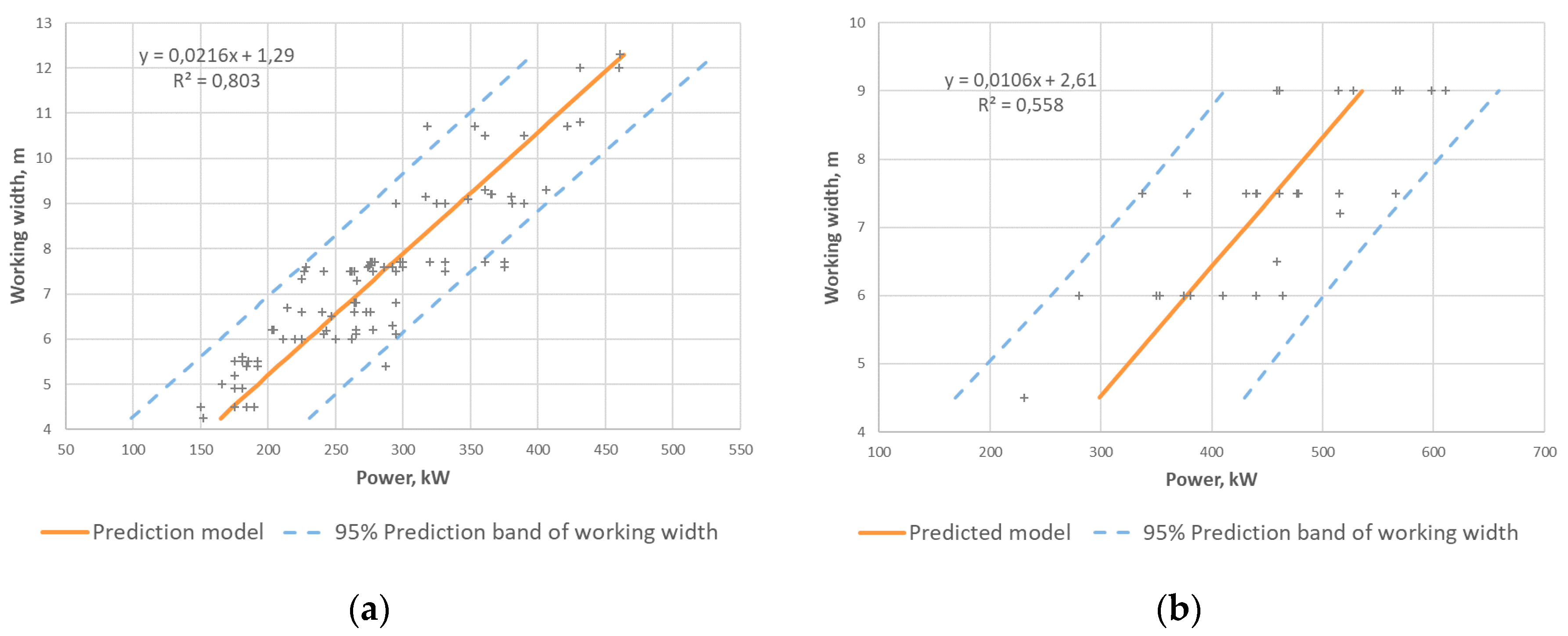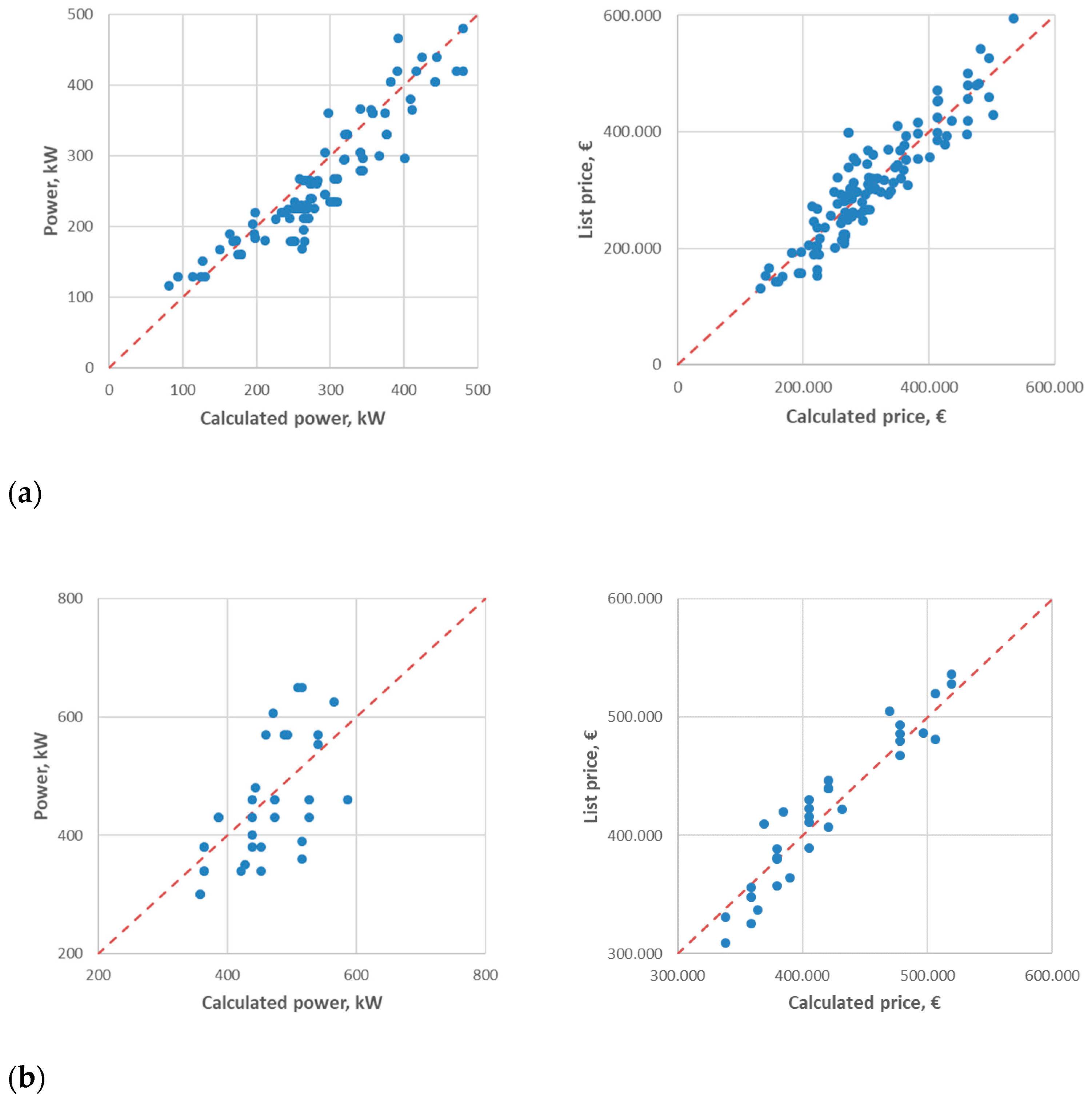Modelling of Harvesting Machines’ Technical Parameters and Prices
Abstract
1. Introduction
2. Materials and Methods
3. Results and Discussion
3.1. Linear Modelling
3.1.1. Combine Harvesters
3.1.2. Forage Harvesters
3.2. Multiple Linear Modelling
4. Conclusions
Author Contributions
Funding
Acknowledgments
Conflicts of Interest
References
- Patrick, K.; Mrema, G.; Mhlanga, N.; Fynn, M.K.; Kienzle, J.; Mpagalile, J. Sustainable Agricultural Mechanization: A Framework for Africa; Food and Agriculture Organization of the United Nations and the African Union Commission (FAO & AUC): Addis Ababa, Ethiopia, 2018. [Google Scholar]
- Sørensen, C.G.; Bochtis, D.D. Conceptual model of fleet management in agriculture. Biosyst. Eng. 2010, 105, 41–50. [Google Scholar] [CrossRef]
- Kaspar, T.C.; Colvin, T.S.; Jaynes, D.B.; Karlen, D.L.; James, D.E.; Meek, D.W.; Pulido, D.; Butler, H. Relationship between six years of corn yields and terrain attributes. Precis. Agric. 2003, 4, 87–101. [Google Scholar] [CrossRef]
- Søgaard, H.T.; Sørensen, C.G. A model for optimal selection of machinery sizes within the farm machinery system. Biosyst. Eng. 2004, 89, 13–28. [Google Scholar] [CrossRef]
- Sopegno, A.; Busato, P.; Berruto, R.; Romanelli, T.L. A cost prediction model for machine operation in multi-field production systems. Sci. Agric. 2016. [Google Scholar] [CrossRef][Green Version]
- Sørensen, C.G. Workability and Machinery Sizing for Combine Harvesting. Agric. Eng. Int. CIGR J. Sci. Res. Dev. 2003, 5, PM 03 003. [Google Scholar]
- Chen, G. Advances in Agricultural Machinery and Technologies; Taylor & Francis Group: Boca Raton, FL, USA, 2018. [Google Scholar]
- Fuchs, C.; Kasten, J.; Urbanek, M. Trends and potential of the market for combine harvesters in Germany. Machines 2015, 3, 364–378. [Google Scholar] [CrossRef]
- Kutzbach, H.D. Trends in Power and Machinery. J. Agric. Eng. Res. 2000, 76, 237–247. [Google Scholar] [CrossRef]
- Miu, P. Combine Harvesters Theory, Modeling, and Design; CRC Press: Boca Raton, FL, USA, 2016. [Google Scholar]
- Hermann, D. Optimisation of Combine Harvesters Using Model-Based Control. Ph.D. Thesis, Technical University of Denmark, Kgs. Lyngby, Denmark, 2018. [Google Scholar]
- Baerdemaeker De, J.; Saeys, W. Advanced Control of Combine Harvesters. FAC Proc. Vol. 2013, 46, 1–5. [Google Scholar] [CrossRef]
- Hunt, D. Farm Power and Machinery Management, 8th ed.; Waveland Press: Long Grove, IL, USA, 1983. [Google Scholar]
- Bainer, R.; Kepner, R.A.; Barger, E.L. Principles of Farm Machinery; John Wiley Sons Inc.: New York, NY, USA, 1955. [Google Scholar]
- Peart, R.M.; Show, W.D. Agricultural Systems Management: Optimizing Efficiency and Performance; Marcel Dekker, Inc.: New York, NY, USA, 2004. [Google Scholar]
- Buckmaster, D.R. Equipment Matching for Silage Harvest. Appl. Eng. Agric. 2009, 25, 31–36. [Google Scholar] [CrossRef]
- Buckmaster, D.R.; Hilton, J.W. Computerized cycle analysis of harvest, transport, and unload systems. Comput. Electron. Agric. 2005, 47, 137–149. [Google Scholar] [CrossRef]
- Amiama, C.; Pereira, J.M.; Castro, J.; Bueno, J. Modelling corn silage harvest logistics for a cost optimization approach. Comput. Electron. Agric. 2015, 118, 56–65; [Google Scholar] [CrossRef]
- Berruto, R.; Busato, P. System approach to biomass harvest operations: Simulation modeling and linear programming for logistic design. In Proceedings of the ASABE Annual International Meeting, Providence, RI, USA, 29 June–2 July 2008. [Google Scholar] [CrossRef]
- Foulds, L.R.; Wilson, J.M. Scheduling operations for the harvesting of renewable resources. J. Food Eng. 2005, 70, 281–292. [Google Scholar] [CrossRef]
- Cavallo, E.; Ferrari, E.; Bollani, L.; Coccia, M. Attitudes and behaviour of adopters of technological innovations in agricultural tractors: A case study in Italian agricultural system. Agric. Syst. 2014, 130, 44–54. [Google Scholar] [CrossRef]
- Kutzbach, H.D. Approaches for mathematical modelling of grain separation. In Proceedings of the International Conference on Crop Harvesting and Processing, Louisville, KY, USA, 9–11 February 2003. [Google Scholar]
- Bulgakov, V.; Adamchuk, V.; Arak, M.; Olt, J. Mathematical Modelling of the Process of Renewal of the Fleet of Combine Harvesters. Agric. Agric. Sci. Procedia 2015, 7, 35–39. [Google Scholar] [CrossRef][Green Version]
- Philips, P.R.; O’Callaghan, J.R. Cereal harvesting—A mathematical model. J. Agric. Eng. Res. 1974, 19, 415–433. [Google Scholar] [CrossRef]
- Sopegno, A.; Calvo, A.; Berruto, R.; Busato, P.; Bocthis, D. A web mobile application for agricultural machinery cost analysis. Comput. Electron. Agric. 2016, 130, 158–168. [Google Scholar] [CrossRef]
- De Toro, A.; Gunnarsson, C.; Lundin, G.; Jonsson, N. Cereal harvesting-strategies and costs under variable weather conditions. Biosyst. Eng. 2012, 111, 429–439. [Google Scholar] [CrossRef]
- Olt, J.; Küüt, K.; Ilves, R.; Küüt, A. Assessment of the harvesting costs of different combine harvester fleets. Res. Agric. Eng. 2019, 65, 25–32. [Google Scholar] [CrossRef]
- Camarena, E.A.; Gracia, C.; Cabrera Sixto, J.M. A mixed integer linear programming machinery selection model for multifarm systems. Biosyst. Eng. 2004, 87, 145–154. [Google Scholar] [CrossRef]
- Borsato, E.; Tarolli, P.; Marinello, F. Sustainable patterns of main agricultural products combining different footprint parameters. J. Clean. Prod. 2018, 179, 357–367. [Google Scholar] [CrossRef]
- Tieppo, R.C.; Romanelli, T.L.; Milan, M.; Sørensen, C.A.G.; Bochtis, D. Modeling cost and energy demand in agricultural machinery fleets for soybean and maize cultivated using a no-tillage system. Comput. Electron. Agric. 2018. [Google Scholar] [CrossRef]
- Edwards, W. Estimating Farm Machinery Repair Costs; Extension and Outreach, Ag Decision Maker; Iowa State University: Ames, IA, USA, 2015; Volume A3-29. [Google Scholar]
- Pezzuolo, A.; Basso, B.; Marinello, F.; Sartori, L. Using SALUS model for medium and 434 long term simulations of energy efficiency in different tillage systems. Appl. Math. Sci. 2014, 8, 6433–6445. [Google Scholar]
- Hawkins, E.M.; Buckmaster, D.R. Benchmarking Costs of Fixed-Frame, Articulated, and Tracked Tractors. Applied Engineering in Agriculture. Am. Soc. Agric. Biol. Eng. 2015, 31, 741–745. [Google Scholar] [CrossRef]
- Yezekyan, T.; Marinello, F.; Armentano, G.; Trestini, S.; Sartori, L. Definition of Reference Models for Power, Weight, Working Width, and Price for Seeding Machines. Agriculture 2018, 8, 186. [Google Scholar] [CrossRef]
- Yezekyan, T.; Marinello, F.; Armentano, G.; Sartori, L. Analysis of cost and performances of agricultural machinery: Reference model for sprayers. Agron. Res. 2018, 16, 604–614. [Google Scholar] [CrossRef]
- Bochtis, D.D.; Sørensen, C.G.C.; Busato, P. Advances in agricultural machinery management: A review. Biosyst. Eng. 2014, 126, 69–81. [Google Scholar] [CrossRef]


| Characteristic | Description/Type |
|---|---|
| Model | constructing company, series, name |
| Functional mechanism parameters | threshing, separation, cleaning (type, diameter, speed) |
| Type of threshing system | conventional, axial, hybrid |
| Levelling system | fixed, self-levelling, semi-levelling |
| Other parameters | tank capacity, power, pneumatics, etc. |
| Other equipment | standard tires, hydraulics, electronic controls |
| Dimensions | total length/height/width, weight |
| List price | basic machine configuration, without header |
| Variable | Value | |
|---|---|---|
| Combine Harvesters | Forage Harvesters | |
| Power, kW | 110–480 | 300–790 |
| Tank capacity, L | 4200–14,500 | - |
| Weight, kg | 7600–19,500 | 11,000–17,800 |
| Price VAT excl., k€ | 130–595 | 309–545 |
| Weight power index, kg kW−1 | 35.7–87.0 | 18.7–38.6 |
| Power | R2 | St. Error | p-Value |
| P = 0.00077Pr + 23.1 | 0.828 | 33.7 | <0.01 |
| P = 0.026M − 124 | 0.674 | 46.5 | <0.01 |
| P = 0.035C − 63 | 0.821 | 34.5 | <0.01 |
| Weight | R2 | St. Error | p-Value |
| M = 0.022Pr + 8120 | 0.653 | 1510 | <0.01 |
| M = 25.8P + 8020 | 0.674 | 1460 | <0.01 |
| M = 0.98C + 5740 | 0.644 | 1530 | <0.01 |
| Capacity | R2 | St. Error | p-Value |
| C = 0.018Pr + 3680 | 0.676 | 1200 | <0.01 |
| C = 23.4P + 3130 | 0.821 | 891 | <0.01 |
| C = 0.66M − 486 | 0.644 | 1250 | <0.01 |
| Price | R2 | St. Error | p-Value |
| Pr = 1070P + 28,000 | 0.828 | 39,600 | <0.01 |
| Pr = 30.2M − 139,000 | 0.653 | 56,400 | <0.01 |
| Pr = 37.5C − 38,300 | 0.676 | 54,500 | <0.01 |
| Working Width * | R2 | St. Error | p-Value |
| L = 0.0216P + 1.29 | 0.803 | 0.785 | <0.01 |
| Power | R2 | St. Error | p-Value |
| P = 0.00172Pr − 266 | 0.894 | 39.3 | <0.01 |
| P = 0.0547M − 250 | 0.444 | 90.4 | <0.01 |
| Weight | R2 | St. Error | p-Value |
| M = 8.14P + 9270 | 0.444 | 1100 | <0.01 |
| M = 0.0155Pr + 6470 | 0.488 | 1060 | <0.01 |
| Price | R2 | St. Error | p-Value |
| Pr = 519P + 182,000 | 0.894 | 21,600 | <0.01 |
| Pr = 31.4M + 13,000 | 0.488 | 47,600 | <0.01 |
| Working Width * | R2 | St. Error | p-Value |
| L = 0.011P + 2.61 | 0.558 | 0.83 | <0.01 |
| Power | Adjusted R2 | Standard Error | |
| Combine harvester | P= 0.0084M + 0.027C − 110 | 0.843 | 32 |
| Forage harvester | P = 0.055M − 249 | 0.428 | 90.4 |
| Weight | Adjusted R2 | Standard Error | |
| Combine harvester | M= 16.6P + 0.39C + 6780 | 0.688 | 1430 |
| Forage harvester | M = 8.14P + 9270 | 0.428 | 1100 |
| Working width * | Adjusted R2 | Standard Error | |
| Combine harvester | L = 0.00017M + 0.00065C − 1.11 | - | - |
| Forage harvester | L = 0.0005M − 0.15 | - | - |
| Price | Adjusted R2 | Standard Error | |
| Combine harvester | Pr= 890P + 6.9M – 28,000 | 0.837 | 38,500 |
| Forage harvester | Pr = 519P + 182,000 | 0.892 | 21,600 |
© 2020 by the authors. Licensee MDPI, Basel, Switzerland. This article is an open access article distributed under the terms and conditions of the Creative Commons Attribution (CC BY) license (http://creativecommons.org/licenses/by/4.0/).
Share and Cite
Yezekyan, T.; Marinello, F.; Armentano, G.; Trestini, S.; Sartori, L. Modelling of Harvesting Machines’ Technical Parameters and Prices. Agriculture 2020, 10, 194. https://doi.org/10.3390/agriculture10060194
Yezekyan T, Marinello F, Armentano G, Trestini S, Sartori L. Modelling of Harvesting Machines’ Technical Parameters and Prices. Agriculture. 2020; 10(6):194. https://doi.org/10.3390/agriculture10060194
Chicago/Turabian StyleYezekyan, Tatevik, Francesco Marinello, Giannantonio Armentano, Samuele Trestini, and Luigi Sartori. 2020. "Modelling of Harvesting Machines’ Technical Parameters and Prices" Agriculture 10, no. 6: 194. https://doi.org/10.3390/agriculture10060194
APA StyleYezekyan, T., Marinello, F., Armentano, G., Trestini, S., & Sartori, L. (2020). Modelling of Harvesting Machines’ Technical Parameters and Prices. Agriculture, 10(6), 194. https://doi.org/10.3390/agriculture10060194







